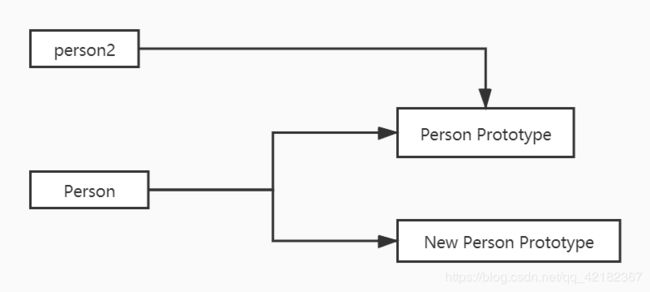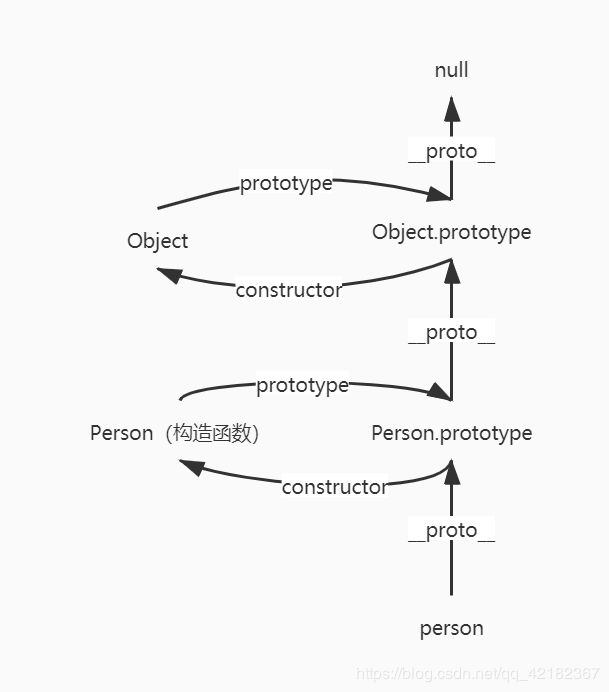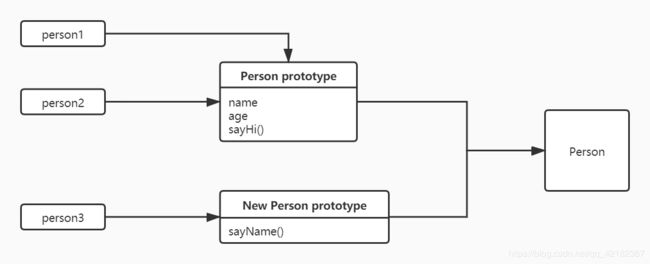JS-创建对象模式-工厂模式、构造函数模式、原型模式、组合模式、动态原型模式、寄生构造函数模式、稳妥构造函数模式
- 工厂模式
- 构造函数模式
- 原型模式
- 原型与原型链
- 构造函数、原型和实例的关系
- 原型的动态性
- 原型模式的缺点
- 组合使用构造函数模式和原型模式(用得最多)
- 动态原型模式
- 寄生构造函数模式
- 稳妥构造函数模式
本文首发于我的个人博客 ruiqima.com
原文链接:JS 创建对象模式
工厂模式
本质:用函数封装创建对象的细节。
特点:
- 显式创建了对象(如
Object) - 不使用
new - 有
return语句 - 缺点:没有解决对象识别问题,即怎样知道一个对象的类型。(如代码倒数第二行的
false)
function createPerson(name, age) {
var o = new Object()
o.name = name
o.age = age
o.sayName = function () {}
return o
}
var person = createPerson('Joker', 23)
console.log(person instanceof createPerson) // false
console.log(person.__proto__) //{}
构造函数模式
特点:
- 没有显式创建对象
- 直接将属性和方法赋给了
this对象 - 没有
return语句 - 创建新实例需使用
new操作符 - 可以解决工厂模式不能确定对象类型的问题
- 缺点:会导致不同实例中的方法不是同一个
Function实例,导致不同的作用域链和标识符解析。(同一个名为sayName的方法在不同实例中是不同Function对象)(如代码倒数第三行的false)
function Person(name, age) {
this.name = name
this.age = age
this.friends = ['1', '2']
this.sayName = function () {}
}
var person1 = new Person('Joker', 23)
var person2 = new Person('Joker1', 24)
person1.friends.push('3')
console.log(person1.friends) //[ '1', '2', '3' ]
console.log(person2.friends) //[ '1', '2' ]
console.log(person1.sayName === person2.sayName) //false
console.log(person1 instanceof Person) //true
console.log(person1.__proto__) //Person {}
原型模式
原型与原型链
我们创建的每个函数都有一个prototype属性,即原型属性。prototype属性是一个指针,指向一个包含可以由特定类型的所有实例共享的属性和方法的对象。
prototype就是通过调用构造函数而创建的那个对象实例的原型对象,使用原型对象的好处是可以让所有对象实例共享包含的属性和方法。
构造函数、原型和实例的关系
每个构造函数都有一个原型对象,原型对象都包含一个指向构造函数的指针,而实例都包含一个指向原型对象的内部指针。
什么叫让所有对象实例共享包含的属性和方法
直接在对象实例上定义方法的缺点是,不同对象实例中包含的方法不是同一个Function实例——在ECMAScript中的函数是对象,每定义一个函数,就是实例化一个对象。以这种方式创建函数,会导致不同的作用域链和标识符解析。
而使用原型对象则可以做到让所有对象实例共享包含的属性和方法。
function Person() {}
Person.prototype={
name : 'defaultName',
age = 'defaultAge'
}
Person.prototype.sayName = function () {
console.log(this.name)
}
var person1 = new Person()
var person2 = new Person()
//使用原型对象的好处,可以让所有对象实例共享它所包含的属性和方法
console.log(person1.sayName == person2.sayName) // true
ObjectName.prototype.isPrototypeOf(instanceName)
实例instanceName的原型是否是ObjectName.prototype。
Object.getPrototypeOf(instanceName)
获取实例instanceName的原型的名称。
var person = new Person()
console.log(Person.prototype.isPrototypeOf(person)) // true
console.log(Object.getPrototypeOf(person) == Person.prototype) //true
原型的动态性
对原型对象的修改会及时体现在实例上,就算在实例创建以后。
var person1 = new Person()
Person.prototype.sayHi = function () {
console.log('sayHi')
}
person1.sayHi() // sayHi
但是,如果重写整个原型对象,情况则会不一样。
var person2 = new Person()
Person.prototype = {
sayName: function () {
console.log('sayName')
},
}
person2.sayName() // person2.sayName is not a function
原因如下图,初始化person2时与原来的Person.prototype有联系,重写了Person.prototype之后相当于新new了一个出来,与原来那个已经不是同一个了。

在此之后,如果再新建对象实例,则会与新new的prototype建立联系,会拥有新prototype上面的属性,但不会拥有原prototype上的属性。
var person3 = new Person()
console.log(person3.name) // undefined
person3.sayName() // sayName
原型模式的缺点
本质是原型中的所有属性被很多实例共享的问题。对于是基本类型值的属性不要紧,但是对于引用类型属性,更改一个实例上的该属性值,会导致所有实例中的该属性值都被更改——因为改引用类型值是存在于对象原型Prototype上的,而不是对象实例中。
function Person() {}
Person.prototype = {
arrays: ['1', '2'],
}
var person1 = new Person()
var person2 = new Person()
person1.arrays.push('3')
console.log(person1.arrays) // [ '1', '2', '3' ]
console.log(person2.arrays) // [ '1', '2', '3' ]
因此,很少单独使用原型模式。
组合使用构造函数模式和原型模式(用得最多)
为解决上述问题,组合使用构造函数模式与原型模式。
优点:构造函数模式用于定义实例,原型模式用于定义方法和共享的属性。每个实例都会有自己的一份实例属性的副本,又共享着对方法的引用,最大限度的节省了内存。这种混成模式还支持向构造函数传递参数。
// 1. 构造函数模式
function Person(name, age) {
this.name = name
this.age = age
this.friends = ['A', 'B']
}
// 2. 原型模式
Person.prototype = {
constructor: Person, //会让constructor变为可枚举的属性
sayName: function () {
console.log(this.name)
},
}
var person3 = new Person('Joker', 23)
var person4 = new Person('Rekoj', 32)
// 共用方法(通过原型定义)
// 但引用类型的属性不会相互干扰(通过构造函数模式定义)
person3.friends.push('fox')
console.log(person3.friends) // [ 'A', 'B', 'fox' ]
console.log(person4.friends) // [ 'A', 'B' ]
console.log(person3.friends === person4.friends) // false
console.log(person3.sayName === person4.sayName) //true
动态原型模式
原理跟组合使用构造函数模式和原型模式一样,但是把原型定义操作封装在了构造函数中。本质是通过构造函数初始化原型。
在构造函数中的if语句是为了判断是否在该对象上定义了sayName的方法——也就是说,当Person的原型上还未定义sayName方法时(如第一次执行new Person(...)语句时),if语句会执行,即进行原型的初始化;一旦Person的原型被初始化过(如第二次执行new Person(...)语句时),根据原型的动态性,sayName已被定义,不会再进入if语句中。
function Person(name, age, job) {
this.name = name
this.age = age
this.friends = ['A', 'B']
if (typeof this.sayName != 'function') { // !important
Person.prototype.sayName = function () {
console.log(this.name)
}
}
}
var person3 = new Person('Joker', 23, 'tricker')
var person4 = new Person('Rekoj', 32, 'rekcirt')
person3.friends.push('fox')
console.log(person3.friends)
console.log(person4.friends)
console.log(person3.friends === person4.friends)
console.log(person3.sayName === person4.sayName)
且如果原型上需要定义多个方法和属性,也只需要一个if语句判断,选其中一个属性或方法判断即可。
要特别注意的是,if语句中的Person.prototype不能使用对象字面量重写原型,原因之前说过,会切断现有实例与新原型之间的联系。
寄生构造函数模式
使用情况:如,想创建一个具有额外方法的特殊数组,由于不能直接写修改Array构造函数,因此可以使用这个模式。
特点:
- 不能依赖instanceof操作符来确定对象类型(如下面的例子,array是instanceof Array,但不是SpecialArray)
- 使用
new操作符
function SpecialArray() {
var values = new Array()
values.push.apply(values, arguments)
values.toSpecialString = function () {
return this.join('+')
}
return values
}
var array = new SpecialArray('a', 'b', 'c')
console.log(array.toSpecialString()) // a+b+c
console.log(array instanceof SpecialArray) // false
console.log(array.__proto__) // []
console.log(array instanceof Array) // true
稳妥构造函数模式
特点:
- 适用于一些安全的环境中(如会禁止使用
this和new),或防止数据被其它应用程序改动(如只允许通过方法访问到属性值) - 新创建对象的实例方法不使用
this - 不适用
new操作符 - 不能依赖instanceof操作符来确定对象类型(跟寄生构造函数模式类似)
function Person(name, age) {
var o = new Object()
o.sayName = function () {
console.log(name)
}
return o
}
var person = Person('Joker', 23)
console.log(person.name) //undefined
person.sayName() //Joker
本文首发于我的个人博客ruiqima.com。
原文链接:https://www.ruiqima.com/zh/post/js-createobj/
本博客内文章除特别声明外均为原创,采用CC BY-NC-SA 4.0 许可协议进行许可。超出CC BY-NC-SA 4.0 许可协议的使用请联系作者获得授权。

